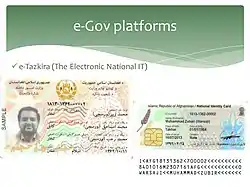Afghan identity card
The Afghan identity card or Afghan Tazkira is a national identity document issued to all citizens of Afghanistan,[1] whether they reside inside or outside of Afghanistan. It serves as proof of identity and residency but more importantly Afghan citizenship. The document is issued by Afghanistan's National Statistics and Information Authority (NSIA).[2][3][4][5]
| Afghan Tazkira | |
|---|---|
 Sample of the current Afghan e-Tazkira | |
| Type | National identity card |
| Issued by | |
| Purpose | Identification |
| Eligibility | 18 years old; citizen of Afghanistan |
| Expiration | 5 to 10 years |
The Afghan Tazkira, which is as old as Afghanistan's history, has been modernized in recent years. The electronic identification (e-ID) card campaign was officially launched in Kabul on 3 May 2018 when President Ashraf Ghani and the First Lady, Rula Ghani, were handed their e-ID cards. Distribution of the e-ID cards or e-Tazkira later began in other parts of Afghanistan. The new e-ID card complies with international standards for identity documents.[6] As of January 2021, approximately 1.7 million Afghan citizens have obtained (and are using) their e-Tazkira cards.[7][8]
Procedure
In order to obtain an Afghan Tazkira, an application must be submitted inside the office of Afghanistan's Ministry of Interior Affairs.[9] The e-Tazkia cards are issued by NSIA.[10] The processing fee of Afghan electronic national ID card is 10 Af inside Afghanistan but €10.EURO in Europe and $10 in America,[11] and the card is valid for five years. Evidence that the applicant is in fact a national and citizen of Afghanistan is required. This can be proven by providing older Afghan paper identification. If the applicant does not have such a document, then he or she must bring family members, relatives or witnesses willing to testify. Applicants below 18 years old must be accompanied by their parents or legal guardians before the application can be processed.[12]
Characteristics
The Afghan e-ID card is plastic and rectangular in shape, about 86 × 54 millimeters in size. On one side is a gold-plated contact chip, and on the right-hand side is the small photograph of the bearer, personal information is available in English on the same side. On the top of the card on both sides, the name Afghanistan is written in three languages, Pashto, Dari and English. On the back side is personal information about bearer in two languages Pashto and Dari. The e-ID card can be used as a smart card.[13]
Printed data
The descriptions of the fields are printed in Pashto, Dari and English.
- Given name
- Surname
- Personal Id. No.
- Holder's signature
- Place of birth
- Date of birth
- Authority
- Date of issue
- Date of expiry
A machine readable zone is printed on the bottom of the back-side of the card.[14]
See also
References
- "Women's access to identification cards can accelerate development in Afghanistan". blogs.worldbank.org. October 5, 2020. Retrieved 2021-02-07.
- "Ghazni residents blast long lasting CNIC process". Pajhwok Afghan News. 15 December 2020. Retrieved 2020-12-10.
- "Kandahar residents want CNIC process accelerated". Pajhwok Afghan News. 10 December 2020. Retrieved 2020-12-10.
- "Farah begins issuing electronic ID cards to residents". Pajhwok Afghan News. 19 September 2020. Retrieved 2020-12-10.
- "Paktia residents want CNIC process accelerated". Pajhwok Afghan News. 4 August 2020. Retrieved 2020-12-10.
- "Distribution of e-ID cards to start on May 3, 2018". TOLOnews. May 3, 2018. Retrieved 2018-05-06.
- "20pc of Afghans to get electronic ID cards next year". Pajhwok Afghan News. 10 January 2020. Retrieved 2021-02-07.
- https://pajhwok.com/2021/02/04/over-a-million-people-received-e-id-cards-last-year-rasouli
- https://www.afghanistanembassy.no/consular-services/absentee-tazkira/
- https://www.munich.mfa.af/consular-affairs/absentee-tazkira.html
- https://www.afghanembassy.us/absentee-tazkira/
- "mfa.gov.af".
- "Kabultimes". Archived from the original on 2018-05-06.
- "mcit.gov.af". Archived from the original on May 7, 2018.